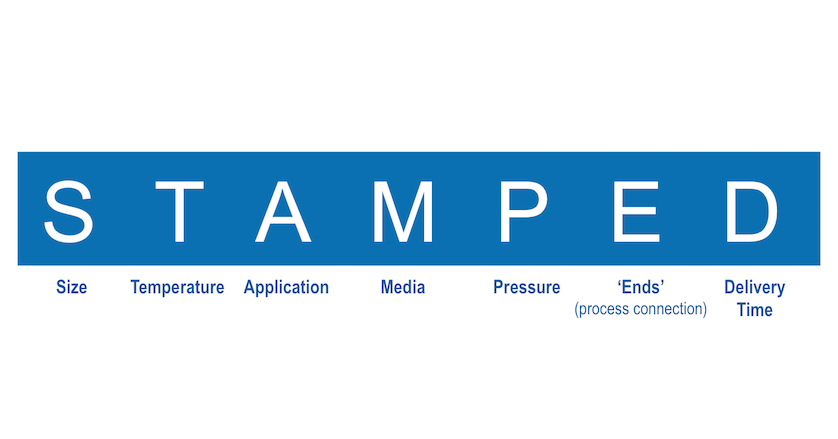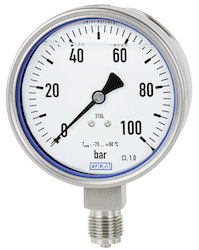
Many factors go into the decision of which industrial pressure gauge to purchase. Asking the “STAMPED” questions regarding Size, Temperature, Application, Media, Pressure, “Ends,” and Delivery time will help buyers determine which gauges are right for their specific situation.
Selecting a pressure gauge is a lot like buying a car. The marketplace is filled with manufacturers, each offering various makes and models with different features. When deciding on a vehicle, buyers look at factors such as the seats and storage space needed (two-seater, sedan, station wagon, minivan), primary driving conditions (city, highway, racing, towing), transmission type (manual, semi-automatic, automatic), and fuel (gasoline, hybrid, electric, hydrogen fuel cell). Cost, of course, is another important consideration.

CPG1500 digital pressure gauge
When choosing a pressure gauge, buyers go through a similar process but with different priorities. Here’s a quick tutorial on how to select a pressure gauge.
Digital or Mechanical Pressure Gauge?
In the world of pressure measurement, the equivalent of a supercar is a digital gauge. With an accuracy of up to ±0.025% of span, this instrument is so precise and high-performance that it can be used for calibration. Top-of-the-line digital gauges like the CPG1500 also communicate wirelessly, a necessity for remote monitoring and industrial IoT (Internet of Things). Understandably, digital gauges are expensive.
Most industrial processes do not require that level of accuracy or number of features. A mechanical, or analog, pressure gauge is sufficient.
Steps for Selecting a Mechanical Gauge
There’s a simple mnemonic for remembering the seven factors for gauge selection: STAMPED.
1. Size
Mechanical pressure gauges come in a variety of nominal sizes, and the one you choose depends on your requirements for readability, space, and precision. The larger the dial face, the more gradations it will have for more exact readings, and the easier it can be seen from a distance – an important consideration if technicians cannot get close to the gauge. However, some applications don’t have room for a large pressure gauge. WIKA gauges range from 1.5″ (40 mm) to 10″ (250 mm).
Another factor to keep in mind is that the size of the end connection will determine what sizes of gauge are available. For example, a 1.5″ gauge is too small to accommodate a ½ inch size connection, based on the wrench flat area in proportion to the case profile.
Regardless of the gauge size, low-light situations make it difficult to read a dial. At WIKA, many of our gauge dial faces come with the option of InSight™, a retro-reflective material, or InSight Glow™, which is InSight™ with the addition of photo luminescence for visibility during power outages.

PG23LT pressure gauge for ambient temperatures as low as −94°F (−70°C)
2. Temperature
Both the ambient temperature and media temperature will determine the material of the wetted parts (brass, stainless steel, nickel alloy, etc.) and whether it will have a dry case or be liquid-filled. The lower the ambient temperature, the more likely it is that a liquid-filled gauge is the right choice. Gauges in extremely cold environments, like the oil fields around the Arctic Circle, are filled with a special low-temperature silicone oil to prevent the internal parts from icing.
If the media temperature will reach 140°F (60°C) or higher, use a stainless steel gauge. This is because brass gauges are soldered, and solder begins to break down at that temperature. We’ve seen customers who used brass gauges for steam applications based on price, and those gauges failed since steam exceeds the 140°F threshold for solder. SS gauges can withstand temperatures up to 392°F (200°C), depending on the configuration.
3. Application
Basically, in what industry will the gauge be used? Here are some examples: Gauges for drinking water applications need to be lead-free, while process industries like refineries and pharmaceuticals require industrial process gauges. Cryogenic gas tanks call for a pressure solution that measures both differential pressure and working pressure, and is cleaned for oxygen service. Gauges used in sanitary processes must have a hygienic design. The highly aggressive gases used in the semiconductor industry means these applications need gauges with an ultra-high purity (UHP) design. What‘s more, some applications require special approvals. For example, gauges for use with fire sprinklers must have UL (Underwriter Laboratories) and FM (Factory Mutual) approvals.

910.12.300 snubber with adjustment screw
For reliability and long service life in high-vibration applications, use a liquid-filled gauge to dampen movement and protect the instrument’s internal mechanism. Note that in high-pressure cycles (pulsation), liquid fill should be used in conjunction with a restrictor or a snubber.
Some common questions we hear have to do with these accessories. What’s the difference between a restrictor and snubber? Besides dimensional restraints, when would a snubber be the better choice? Restrictors are a less expensive option for gauges in applications with dynamic pulsation. However, they are limited based on the orifice size, and they are prone to clogging in debris-filled media such as wastewater. Snubbers mitigate dynamic pulsations and pressure spikes much like restrictors, but they come in a wider range of sizes and are not as prone to clogging. Snubbers are also more adjustable in the field with the use of interchangeable pistons or external adjustment screws, and this flexibility reduces downtime.
4. Media
The media that the pressure gauge, especially its wetted parts, comes in contact with will determine the gauge material. In other words, what’s in the pipeline? A brass (copper alloy) gauge is suitable for water, air, or other non-aggressive liquids or gases. But sour gas (hydrogen sulfide), ammonia, creosote, and other harsh chemicals require corrosion-resistant materials such as stainless steel or a nickel-copper alloy like Monel®. For media that can clog gauge mechanisms, opt for the addition of a diaphragm seal, which provides a physical barrier between the fluid and the pressure instrument.
The media also affects the type of case filling used. Glycerin is the standard fill fluid for non-oxidizing environments, while highly reactive media call for an inert oil like Halocarbon or Fluorolube®.
5. Pressure
This question encompasses several aspects. First, what type of pressure do you need to measure – gauge pressure (working pressure), absolute pressure, or differential pressure?
Second, what is the operating range of the application? In general, select a gauge whose range is 2X the optimal operating pressure, as this ensures the best performance. Standard pressure gauges can handle up to 20,000 psi (1,600 bar), with specialty products like the PG23HP-P going as high as 87,000 psi (6,000 bar). For low pressure measurements, use a capsule gauge to detect small pressure differences in units such as millibar (mbar), inches of water column (inH2O), or ounces per square inch (oz/in2).
Finally, what is the desired pressure scale? Gauges come in a variety of measurement units – e.g., psi, bar, kPa, inH2O. All WIKA gauges can be customized, such as dual scale, triple scale, or custom scales, based on your application needs.
6. “Ends” (process connections)
What “ends,” or process connections, do you need? The most common type in the U.S. and Canada is NPT, while other countries tend to use G (metric) connections. Then for each type there’s the question of connection size, such as ⅛, ¼, and ½. And finally, the location of the process connection; the two most common connection locations to choose from are lower (bottom) mount or back (rear) mount.
7. Delivery time
Most buyers don’t consider this last factor, but the issue of delivery time is very relevant. If you need a large quantity by tomorrow, your choices will be standard gauges in popular nominal sizes that are already on the shelf. But if you can wait a few weeks, you’ll be able to get the exact pressure gauge you want with all the desired options.
WIKA’s System for Model Numbering
With a few exceptions, WIKA’s mechanical gauges have a five-digit model number. The system may look complicated, but it’s really quite simple. Let‘s take the model 213.40 Bourdon tube pressure gauge as an example.

A. Instrument series or type1 = standard (100 series): general purpose, low cost B. Basic instrument type0 = special type C. Case filling0 = special type | D. Design features10 = standard design (lower mount connection in 100 series)
|
Using this chart, we can see that the 213.40 is an industrial gauge (200 series) made of brass, is liquid-fillable/liquid-filled, and has a forged brass case. This is WIKA’s hydraulic gauge, as it is designed to withstand extreme shock, vibration, and pulsation.
WIKA is known throughout the world for our comprehensive portfolio of pressure gauges for almost every industrial application. For more information about selecting the right pressure gauge, contact the experienced pressure specialists at WIKA USA.


I am looking for digital pressure gauge and flow meter in Chennai. Need more information
Dear Ananth, thank you for reading the WIKA blog. I am assuming you referred to Chennai in India. My recommendation for you is to contact WIKA India and provide them with the necessary specification so they can select the correct product for you. The WIKA India headquarters is located in the Village Kesnand, Wagholi. Please follow this link for the complete contact information:
Best regards,
Hardy Orzikowski
Hi wika.us owner, You always provide useful information.
To the wika.us admin, Your posts are always well-cited and reliable.